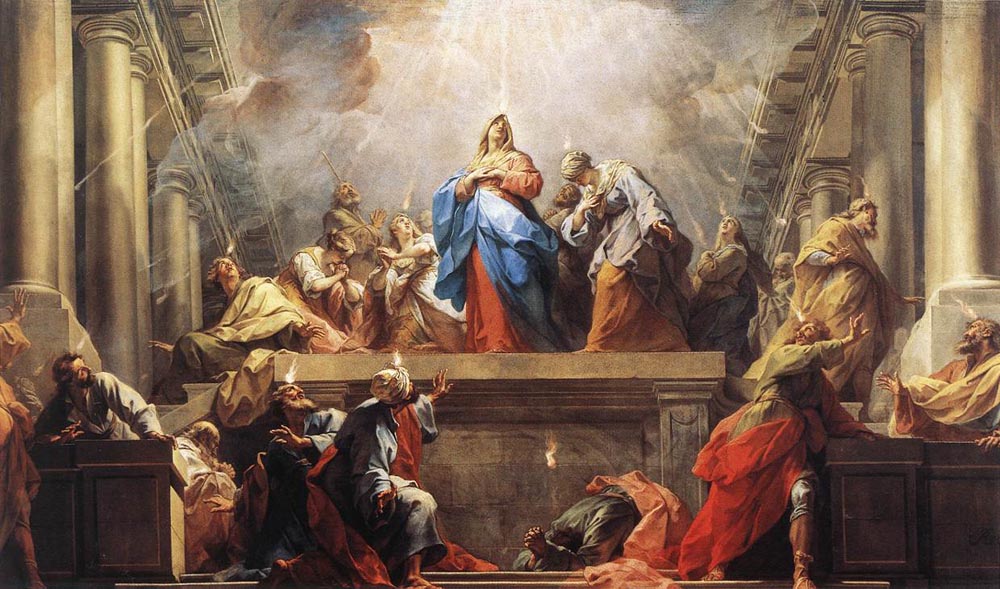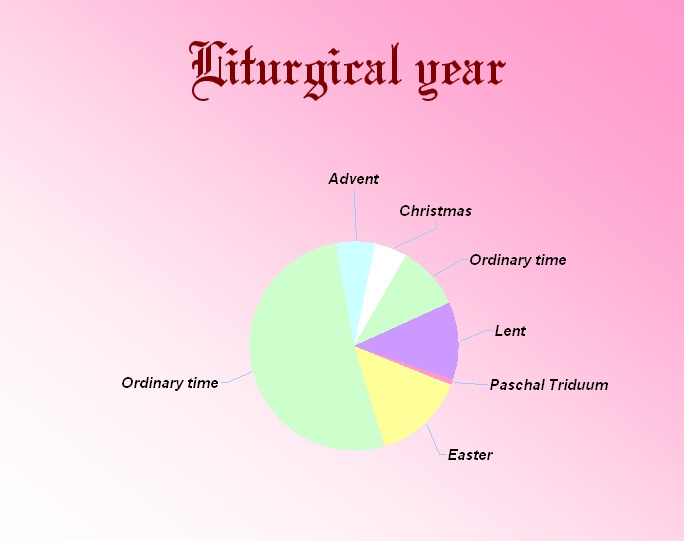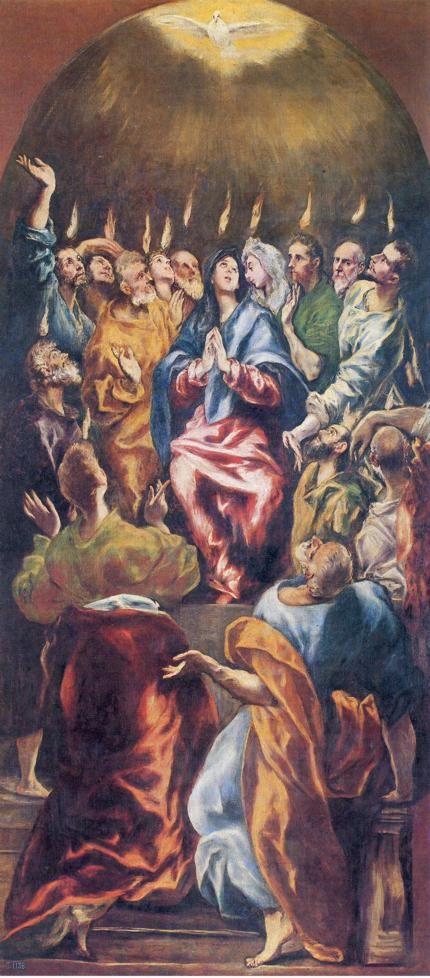
An artist’s depiction of Pentecost – the “birthday of the Church…”
* * * *
Pentecost Sunday is coming up on May 24th. The word “Pentecost” comes from the Greek for “the 50th day,” and it’s always celebrated 50 days after Easter Sunday. (That’s “seven weeks plus one day.”) And it’s been around a long, long time. See Pentecost – Wikipedia:
Pentecost is the Greek name for the Feast of Weeks, a prominent feast in the calendar of ancient Israel celebrating the giving of the Law on Sinai. This feast is still celebrated in Judaism as Shavuot. Later, in the Christian liturgical year, it became a feast commemorating the descent of the Holy Spirit upon the Apostles and other followers of Jesus Christ (120 in all), as described in the Acts of the Apostles [verses 1-13 et seq.].
Another name for Pentecost is Tongue Sunday. For one thing there were the “tongues of fire” that appeared that day, as shown in the El Greco painting below. (See also Acts 2:3.)
![]() For another thing there was the “speaking in tongues” – also known as glossolalia, as shown at left – that was such a feature of the original Pentecost. See Acts 2:4, “All of them were filled with the Holy Spirit and began to speak in other tongues as the Spirit enabled them.“
For another thing there was the “speaking in tongues” – also known as glossolalia, as shown at left – that was such a feature of the original Pentecost. See Acts 2:4, “All of them were filled with the Holy Spirit and began to speak in other tongues as the Spirit enabled them.“
That made some onlookers skeptical, even at the time. As noted in Acts 2:12 and 13, some people who saw the event were amazed, but “others sneered and said, ‘They are filled with new wine!'”
But as Isaac Asimov noted, the Apostles weren’t just “babbling.”
Instead they spoke in concrete, known languages. As a result, people from a host of different nations could understand them. As Asimov put it, “in their ecstasy, they uttered phrases in both languages” – i.e., the “marketplace” Koine Greek prominent at the time, or the disciples’ native Aramaic – so that “those who listened to them from the various nations … would have understood something.” (See Readings for Pentecost (6/8/14).) See also Acts 2, verse 8-11:
“How is it that we hear, each of us, in our own native language? Parthians, Medes, Elamites, and residents of Mesopotamia, Judea and Cappadocia, Pontus and Asia, Phrygia and Pamphylia, Egypt and the parts of Libya belonging to Cyrene, and visitors from Rome, both Jews and proselytes, Cretans and Arabs – in our own languages we hear them speaking about God’s deeds of power.”
(See also 1st Corinthians 14:19, on the potential abuse of that “gift,” where the Apostle Paul said that while he was glad he could speak in tongues, in church “I would rather speak five intelligible words to instruct others than ten thousand words in a tongue.”)
For another view of this “first Pentecost,” see What is Pentecost? (Patheos):
Before the events of the first Pentecost … a few weeks after Jesus’ death and resurrection, there were followers of Jesus, but no movement that could be meaningfully called “the church.” Thus, from an historical point of view, Pentecost is the day on which the church was started. This is also true from a spiritual perspective, since the Spirit brings the church into existence and enlivens it. Thus Pentecost is the church’s birthday.
 Another thing that Pentecost does is mark the beginning of “Ordinary Time,” as it’s called in the Catholic Church, and shown in the chart at left.
Another thing that Pentecost does is mark the beginning of “Ordinary Time,” as it’s called in the Catholic Church, and shown in the chart at left.
Such “Ordinary Time” takes up over half the church year, though in the Episcopal Church and other “Protestant” denominations, it goes by another name. That is, in the Anglican liturgy, the Season of Pentecost begins on the Monday after Pentecost Sunday and goes on “through most of the summer and autumn.” It may include as many as 28 Sundays, “depending on the date of Easter.” (See also the List of Anglican Church Calendars.)
In other words, this year – 2015 – the Season of Pentecost begins on Monday, May 25, and doesn’t end until Saturday, November 28. That’s Thanksgiving Weekend, and the day after that – November 29 – marks the First Sunday of Advent, and with it the start of a new liturgical year.
Also, the readings for each Sunday – from June 7 to November 22 – are designated as a given “Sunday after Pentecost,” with a given “Proper” number. For example, the Bible readings for Sunday August 16 – right about the middle of the Season of Pentecost – are designated as those for the Twelfth Sunday after Pentecost – Proper 15.
But the key point to remember is that it wasn’t only people who were already Christians who saw the Pentecost in Acts as a miracle; “so did the onlookers … for many were converted to the belief in Jesus as Messiah.” (Asimov, 1002-1003) Or as was noted in Acts 2:41, “the same day there were added unto them about three thousand souls.”
To sum up, the Pentecost described in Acts “was a momentous, watershed event.” For the first time in history, God had empowered “all different sorts of people for ministry. Whereas in the era of the Old Testament, the Spirit was poured out almost exclusively on prophets, priests, and kings,” on this Day of Pentecost the Holy Spirit had been given to “‘all people.’ All would be empowered to minister regardless of their gender, age, or social position.” (See What is Pentecost? Why Does It Matter? – Patheos, noted above and emphasis added.)
* * * *

The upper image is courtesy of Pentecost – Wikipedia, with the caption: “A Western depiction of the Pentecost, painted by Jean II Restout, 1732.”
The version at left is courtesy of El Greco. Pentecost – Olga’s Gallery. See also El Greco | Hear what the Spirit is saying, with the following notes by Hovak Najarian, on “The Pentecost, Oil on Canvas,” circa1600:
“Its height above floor level would place the seminarians at the lower part of the painting and they would see the subject matter increase in complexity as their gaze moved upward toward Mary, the apostles, and the plumes of fire. A dove at the top of the painting represents the Holy Spirit; its wings are spread and the light that surrounds it is radiating downward over the gathering.
“The two men in the foreground at the bottom of a short flight of stairs have lifted their arms and are leaning back slightly in order to look at the dove. Mary (dressed in red and blue) is seated at the center of the painting with apostles gathered around her; two other women are included in the painting.
“The woman at Mary’s left shoulder is thought to be Mary Magdalene and the fourth person from the left side may be Martha… El Greco also included himself in this painting. His face is second from the right; he is the man with a white beard who seems to be in deep thought and is not looking up toward the dove.
“Although the term, ‘Expressionism,’ did not come into use until the twentieth century, it is an apt term for El Greco’s late paintings. Expressionism is the result of an artist’s effort to project emotional intensity and inner feelings into a work. The figures in The Pentecost are not posing for a formal group portrait. They are an animated informal mix of people who in body language and facial expression are reacting individually, and yet they are part of the collective experience. They are responding with awe and excited emotional involvement as they take part in this miraculous event.”
On the subject of “Propers” in the liturgical year, and especially in the season of Pentecost. A “proper” definition of the term Proper is far beyond the scope of the themes explored in this blog. However, those interested in further information on this rather ethereal concept are directed to web articles including but not limited to The Revised Common Lectionary, Proper Ordinary Time | Liturgy, and/or Lectionary #, Proper #, or Sunday after Pentecost?
For more on the issue of speaking in tongues, see On the readings for Pentecost (6/8/14), which noted in part that such “speaking” refers to the “fluid vocalizing of speech-like syllables that lack any readily comprehended meaning, in some cases as part of religious practice. Some consider it as a part of a sacred language. It is a common practice amongst Pentecostal and Charismatic Christianity:”
On the other hand, it could be argued this is another example of some people taking isolated Bible passages out of context, like those who handle snakes based on Mark 16:17-18, or those who have a “quiverfull” of children based on a passage from Psalm 127. (See Snake handling – Wikipedia, and QuiverFull .com :: Psalm 127:3-5.)